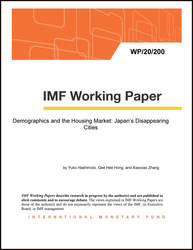
Demographics and the Housing Market: Japan’s Disappearing Cities
Demographics and the Housing Market: Japan’s Disappearing Cities
READ MORE...
Volume/Issue:
Volume 2020
Issue 200
Publication date: September 2020
ISBN: 9781513557700
$18.00
Add to Cart by clicking price of the language and format you'd like to purchase
Available Languages and Formats
| English |
Prices in red indicate formats that are not yet available but are forthcoming.
Topics covered in this book
This title contains information about the following subjects.
Click on a subject if you would like to see other titles with the same subjects.
Inflation , Demography , WP , house price , price , house , housing price , price appreciation , condominium price , price dynamics , price decline , price change , Housing prices , Housing , Population growth , Inflation , population change , house prices , durable housing model , akiya (vacant houses) , regional disparity
Summary
How does a shrinking population affect the housing market? In this study, drawing on Japan’s experience, we find that there exists an asymmetric relationship between housing prices and population change. Due to the durability of housing structures, the decline in housing prices associated with population losses is estimated to be larger than the rise in prices associated with population increases. Given that population losses have been and are projected to be more acute in rural areas than urban areas in Japan, the on-going demographic transition in Japan could worsen regional disparities, as falling house prices in rural areas could intensify population outflows. Policy measures to promote more even population growth across regions, and avoid the over-supply of houses, are critical to stabilize house prices with a shrinking population.
Copyright © 2010 - 2025
Powered by:
AIDC



